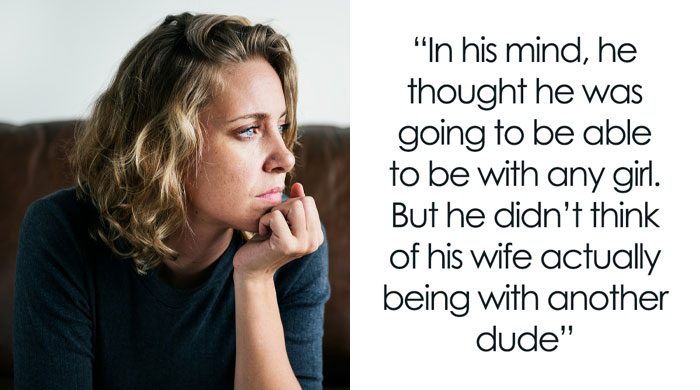
Woman Writes A Detailed Plan For Anyone Who’s Trying To Escape An Abusive Partner
Flip through any women’s magazine and you can find a multitude of articles on how to ‘spice up’ your relationship, ‘please your partner,’ or even get into a relationship – but what is less common is reading about how to get out of a relationship. According to the National Coalition Against Domestic Violence, “On average, nearly 20 people per minute are physically abused by an intimate partner in the United States. During one year, this equates to more than 10 million women and men.”
Abusive behavior can begin with signs such as name-calling, threats, possessiveness, or distrust and gradually grow into physical violence. These situations can be difficult and life-threatening to get out of, so one woman posted some advice online.
1 in 4 women in the U.S experience severe intimate partner physical violence – someone online shared a safety escape plan

Image credits: iStock / SolStock (not the actual photo)
On Facebook, one user ‘Maddie’ shared a step-by-step guide for anyone who had questions on if and how they should leave their abusive partner. The safety plan was broken down into sections such as finances, possessions, housing, family and work. In the plan, it focused on how to go off the grid, as 60.8% of female stalking victims in the U.S reported being stalked by a current or former intimate partner.
A Facebook user by the name of ‘Maddie’ wrote step-by-step instructions on how to leave an abusive partner and start over with financial, work, and housing advice
Domestic abuse appears in many forms and abusers may try to convince the person they are abusing that their behavior is coming from a place of love. Before physical abuse occurs or during it is important to be aware of the signs. According to NCADV abusive tendencies can include the following:
Isolating the victim financially by taking their money or refusing to give them money for their expenses. Controlling how all of the money in the household is spent. Interferring in the victims work life by preventing them from going to work, harassing them at their workplace or keeping them up all night so they perform badly.
Another sign is negatively affecting their relationships with other people, including friends and family. They might discourage the victim from seeing their friends and family members, tell them they are a bad parent and threaten to take away or hurt their children. If they do allow the victim to spend time with other’s they might display signs of jealousy and dictate who and when you can see others.
Chiping away at self-esteem is another technique abusers use to control their victims. This can include shaming or embarassing them with put-downs, dictating their physical appearance, and telling them they can never do anything right.
Physical abuse can harm a person’s health in more than one way. Abusers may force their partner to have sex with others, sabotage their birth control or refuse to use protection, pressure them to use drugs or alcohol or forcing them to have sex with the abuser when they don’t want to. Almost half of female (46.7%) and male (44.9%) victims of rape in the United States were raped by an acquaintance. Of these, 45.4% of female rape victims and 29% of male rape victims were raped by an intimate partner.11
People in the comments added more advice to the guide
244Kviews
Share on FacebookWhen I finally mustered up enough courage to leave, I had a game plan. It took approximately 6 months to get everything done. I send my clothes to my parents' home. I stole from my psycho ex bf. Anything that I knew he wouldn't miss like old cell phones and pagers (this was in the 90s when I left and in the USA). I opened up a new bank account via phone when he wasn't around in the state I was planning on moving to and I deposited all of my money there via mail. I informed the police, the dmv (it was legally my car), the cell phone company, and anyone else I could think of at the time. My biggest mistake was telling our neighbors who were friends who swore they wouldn't say a word-they lied! My job was really supportive of me as well. When he found me states away, I simply reminded him that I still knew a lot of people where I was going and there was a lot of dessert. They had shovels and no one would really miss him! Haven't heard from him since! Hang in there, it can be done! <3
You are amazing! Well done for getting away AND standing up to him! You are so strong! I respect you so much. <3
Load More Replies...One thing I heard was to never post/share somebody looking for somebody that is "missing". A lot of times an abuser will post on social media saying that so and so is missing and track them down this way. Only share "missing" posts if they're accompanied by a phone number to emergency services or put out by the police themselves. As much as you want to help "find" somebody that is "missing", they might not want to be found. Please think twice about sharing this kind of stuff on FB.
Thank you Adam. I truly hadn't thought about that and I shared a "missing" post this morning. I will be a lot more circumspect in future.
Load More Replies...Photos is not something you need to bring, if they aren't digital, just take pictures of them and post online, like on photobucket in a private album. And in many countries, if you have a dog, call the kennel club and make any information they have on your dog private. The same if you have any registered animals in any club.
ADDITIONAL INFORMATION: (point to follow, as there are many).... (EDIT: these are from direct experience, either for myself trying to get out, or when helping friends to get out. This, is for both males and females leaving a DV situation. The DV perpertrator was either sexual partners, family members, or flatmates)
11. do NOT rely on the charities to follow-through with their offers of action. The number of times I heard staff saying they "forgot" to follow through with offers of help, was horrendous. FOLLOW UP with them!!! Confirm WHEN they will let you know - day and time. Call them back within 1 hr of that deadline. If they can't give you a deadline, assume nothing will happen, because your safety is more important than politely waiting for them and hearing nothing.
Load More Replies...I am concerned about revealing aaaallll of this for everyone to read - including abusers... They will now know what to look out for. :-/
I understand your fear but think about this: how many banks are there typically in a town or even surrounding towns? Quite a few, so he would have to search all of them and 10 to 1, none of them will reveal if she/he has a new acct. Another thing, look around at all the things pointed out like housing. There are bunches of apartment companies as well as places like families where one can stay. Sure the abusers have information but that doesn't mean they will find their victims. Make sense?
Load More Replies...I can not believe that people have to think in all this kind of plans, like a movie, "all have to be well planned”, instead of live with peace, this abusers have to pay! They stole time, peace from those inocents, I am so proud for this woman, she deserves all the respect, shes brave!
but you normally do need an escape plan. Leaving an abusive person is TERRIFYING and if you dont plan it out correctly it can go very south . Kudos to this woman for the list!
Load More Replies...I stole his car while he was out copping crack. Left with my baby and everything I could pack in a 1982 Celica.
That last comment is VERY important. Women can abuse men as well. Of course, like male rape, it doesn't get the attention that it should. But it's very real. Men are very reluctant to admit it, because, you know, society judges. No one deserves to be abused. I was abused emotionally and physically as a child, as a young bride, after 25 yrs. of marriage got a divorce. Hardest thing I ever did, but it was worth it.
Good information from Women's Aid in the U.K. about how to cover your tracks online: https://www.womensaid.org.uk/cover-your-tracks-online/
Assuming the abused person wants to leave. . . is is good advise. If the person does not want to leave and brain washed probably won't work
as with everything in life - we must want the change first, before the change can happen. Let's hope that all those who are not willing to accept the DV situation & WANT to get out, are able to. Sadly, I've known many people within my life (from childhood, onwards), whose identity is more tied to appeasing the abuser, than their identity is tied to their safety, or the safety of their children. Horrendous - but sadly, very true.
Load More Replies...When I finally mustered up enough courage to leave, I had a game plan. It took approximately 6 months to get everything done. I send my clothes to my parents' home. I stole from my psycho ex bf. Anything that I knew he wouldn't miss like old cell phones and pagers (this was in the 90s when I left and in the USA). I opened up a new bank account via phone when he wasn't around in the state I was planning on moving to and I deposited all of my money there via mail. I informed the police, the dmv (it was legally my car), the cell phone company, and anyone else I could think of at the time. My biggest mistake was telling our neighbors who were friends who swore they wouldn't say a word-they lied! My job was really supportive of me as well. When he found me states away, I simply reminded him that I still knew a lot of people where I was going and there was a lot of dessert. They had shovels and no one would really miss him! Haven't heard from him since! Hang in there, it can be done! <3
You are amazing! Well done for getting away AND standing up to him! You are so strong! I respect you so much. <3
Load More Replies...One thing I heard was to never post/share somebody looking for somebody that is "missing". A lot of times an abuser will post on social media saying that so and so is missing and track them down this way. Only share "missing" posts if they're accompanied by a phone number to emergency services or put out by the police themselves. As much as you want to help "find" somebody that is "missing", they might not want to be found. Please think twice about sharing this kind of stuff on FB.
Thank you Adam. I truly hadn't thought about that and I shared a "missing" post this morning. I will be a lot more circumspect in future.
Load More Replies...Photos is not something you need to bring, if they aren't digital, just take pictures of them and post online, like on photobucket in a private album. And in many countries, if you have a dog, call the kennel club and make any information they have on your dog private. The same if you have any registered animals in any club.
ADDITIONAL INFORMATION: (point to follow, as there are many).... (EDIT: these are from direct experience, either for myself trying to get out, or when helping friends to get out. This, is for both males and females leaving a DV situation. The DV perpertrator was either sexual partners, family members, or flatmates)
11. do NOT rely on the charities to follow-through with their offers of action. The number of times I heard staff saying they "forgot" to follow through with offers of help, was horrendous. FOLLOW UP with them!!! Confirm WHEN they will let you know - day and time. Call them back within 1 hr of that deadline. If they can't give you a deadline, assume nothing will happen, because your safety is more important than politely waiting for them and hearing nothing.
Load More Replies...I am concerned about revealing aaaallll of this for everyone to read - including abusers... They will now know what to look out for. :-/
I understand your fear but think about this: how many banks are there typically in a town or even surrounding towns? Quite a few, so he would have to search all of them and 10 to 1, none of them will reveal if she/he has a new acct. Another thing, look around at all the things pointed out like housing. There are bunches of apartment companies as well as places like families where one can stay. Sure the abusers have information but that doesn't mean they will find their victims. Make sense?
Load More Replies...I can not believe that people have to think in all this kind of plans, like a movie, "all have to be well planned”, instead of live with peace, this abusers have to pay! They stole time, peace from those inocents, I am so proud for this woman, she deserves all the respect, shes brave!
but you normally do need an escape plan. Leaving an abusive person is TERRIFYING and if you dont plan it out correctly it can go very south . Kudos to this woman for the list!
Load More Replies...I stole his car while he was out copping crack. Left with my baby and everything I could pack in a 1982 Celica.
That last comment is VERY important. Women can abuse men as well. Of course, like male rape, it doesn't get the attention that it should. But it's very real. Men are very reluctant to admit it, because, you know, society judges. No one deserves to be abused. I was abused emotionally and physically as a child, as a young bride, after 25 yrs. of marriage got a divorce. Hardest thing I ever did, but it was worth it.
Good information from Women's Aid in the U.K. about how to cover your tracks online: https://www.womensaid.org.uk/cover-your-tracks-online/
Assuming the abused person wants to leave. . . is is good advise. If the person does not want to leave and brain washed probably won't work
as with everything in life - we must want the change first, before the change can happen. Let's hope that all those who are not willing to accept the DV situation & WANT to get out, are able to. Sadly, I've known many people within my life (from childhood, onwards), whose identity is more tied to appeasing the abuser, than their identity is tied to their safety, or the safety of their children. Horrendous - but sadly, very true.
Load More Replies...
 Dark Mode
Dark Mode 

 No fees, cancel anytime
No fees, cancel anytime 








































































313
111